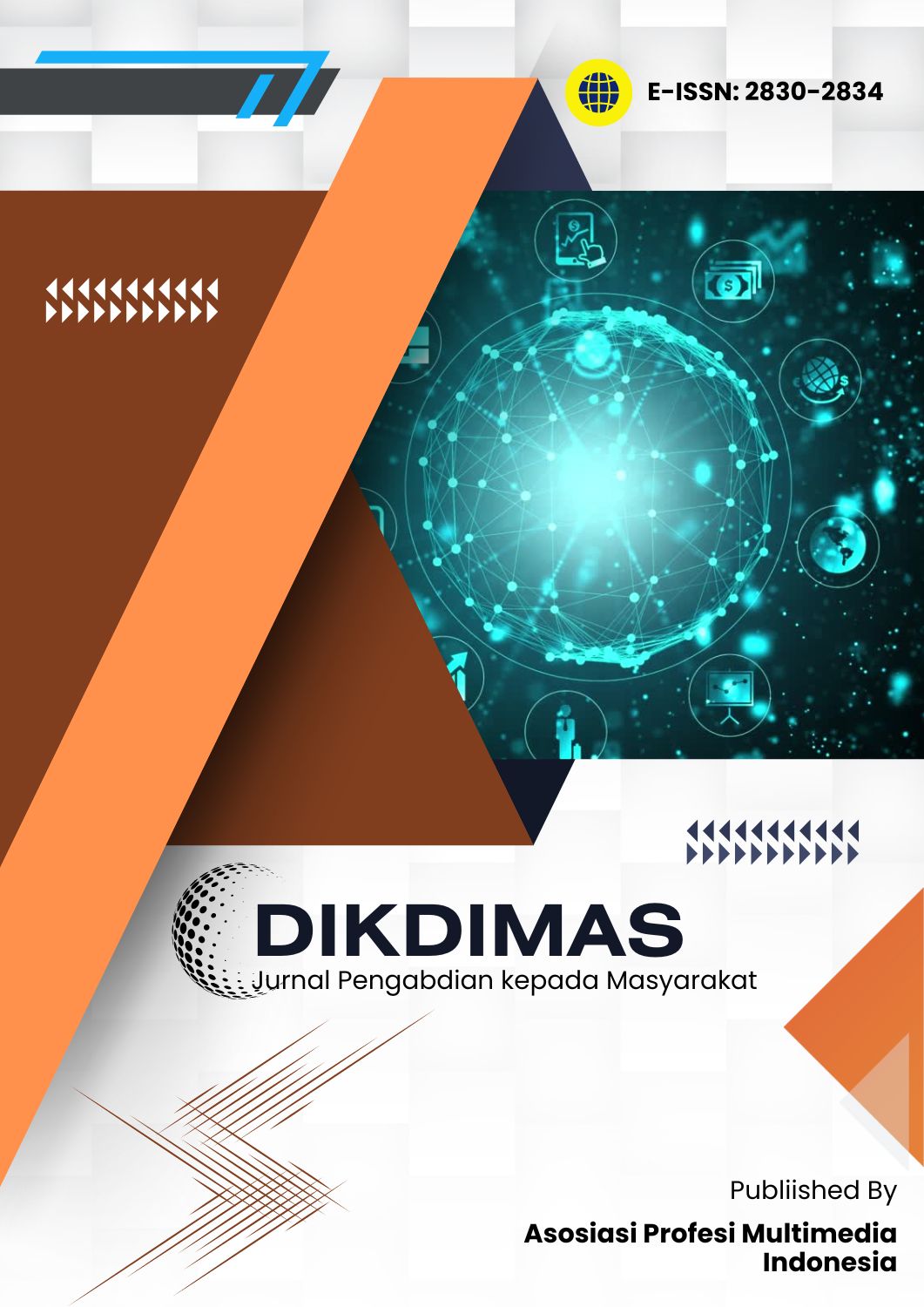Socialization and Demonstration Utilization of Citraimona Plants (Cymbopogon nardus L. Rendle) as an Anti-Mosquito Spray Product in Taba Air Pauh Village
Main Article Content
Abstract
Mosquitoes are often considered to disrupt human life. Various efforts are used to reduce the mosquito population, including using anti-mosquito spray. The anti-mosquito spray that is usually used is chemical-based. This is due to the public's lack of knowledge about the use of plants around them, such as citronella, to be used as an anti-mosquito spray. Therefore, activities were carried out aimed at increasing public understanding about the use of anti-mosquito spray, with a focus on plants around them, such as citronella which can be processed into useful ingredients. Through this outreach, we can provide useful information to the public, making them aware that citronella not only functions as a kitchen spice, but also as an ingredient in making an easy-to-make anti-mosquito spray. This research uses descriptive methods because it involves very specific experiments and research. This work program focuses on outreach and training to the community, from teenagers to adults, regarding the use of anti-mosquito spray from citronella. This activity consists of a preparation stage and an implementation stage. Based on the results of community service in Taba Air Pauh village showed high enthusiasm from the community and had a positive impact on increasing knowledge about the dangers of mosquitoes, chemicals, and making mosquito repellent liquid.
Downloads
Article Details
Copyright (c) 2023 Charles Banon, Agus Martono Hadi Putranto, Amalia Upida Sari, Feni Mia Novianti, Asty Alifah Zahra, Risti Yana, Wahyu Ningsi Qotimah

This work is licensed under a Creative Commons Attribution-ShareAlike 4.0 International License.
- Authors retain copyright and acknowledge that the Journal of Multidisciplinary Applied Natural Science is the first publisher, licensed under a Creative Commons Attribution License.
- Authors are able to enter into separate, additional contractual arrangements for the non-exclusive distribution of the journal's published version of the work (e.g., post it to an institutional repository or publish it in a book), with an acknowledgment of its initial publication in this journal.
- Authors are permitted and encouraged to post their work online (e.g., in institutional repositories or on their website) prior to and during the submission process, as it can lead to productive exchanges and earlier and greater citation of published work.
References
Akbar, H., & Syaputra, E. M. (2019). Faktor Risiko Kejadian Demam Berdarah Dengue (DBD) di Kabupaten Indramayu. MPPKI (Media Publikasi Promosi Kesehatan Indonesia): The Indonesian Journal of Health Promotion, 2(3), 159–164. https://doi.org/10.31934/mppki.v2i3
Budi, A., Nurwindasari, N., Patria, A., Novega, M. D., & Setiawan, S. (2021). Pendidikan Kesehatan Demam Berdarah Dengue (Dbd) Di Puskesmas Kedaton Bandar Lampung. ANDASIH Jurnal Pengabdian Kepada Masyarakat, 2(2), 49–53. https://doi.org/10.57084/andasih.v2i2.713
Dania, I. A. (2016). Gambaran Penyakit dan Vektor Demam Berdarah Dengue (DBD) Perguruan tinggi di Medan, Sumatera Utara. Jurnal Warta, 48(1), 1–15. https://doi.org/10.46576/wdw.v0i48.179
Djarami, J., Pelu, A. D., Dusra, E., & Muhis, S. W. (2022). Formulasi Sediaan Salep Ekstrak Etanol Tanaman Serai Wangi (Cymbopogon nardus) dengan Variasi Basis Salep. Global Health Science, 7(4), 166–171. https://doi.org/10.33846/ghs7404
Fitri, D. R., Fajar, I. R. F., Ekadipta, E., & Hardiyati, I. (2023). Pelatihan Pembuatan Insektisida Herbal Minyak Sereh Bentuk Spray di RPTRA Jeruk Manis. Jurnal Abdimas Jatibara, 2(1), 12–16. https://doi.org/10.29241/jaj.v2i1.1475
Halim, R., & Fitri, A. (2020). Aktivitas Minyak Sereh Wangi Sebagai Anti Nyamuk. Jurnal Kesmas Jambi, 4(1), 28–34. https://doi.org/10.22437/jkmj.v4i1.8940
Husna, R. N., Wahyuningsih, N. E., & Dharminto. (2016). Hubungan Perilaku 3m Plus Dengan Kejadian Demam Berdarah Dengue (Dbd) Di Kota Semarang (Studi Di Kota Semarang Wilayah Atas). Jurnal Kesehatan Masyarakat, 4(5), 170–177. https://doi.org/10.14710/jkm.v4i5.14506
Lesmana, O., & Halim, R. (2020). Gambaran Tingkat Kepadatan Jentik Nyamuk Aedes Aegypti di Kelurahan Kenali Asam Bawah Kota Jambi. Jurnal Kesmas Jambi, 4(2), 59–69. https://doi.org/10.22437/jkmj.v4i2.10571
Maradona, M., & Hujjatusnaini, N. (2022). Pelatihan Pembuatan Lilin Aromaterapi Ekstrak Serei Wangi dari Lilin Parafin Melalui Metode Demonstrasi Terbimbing Untuk Meningkatkan Kreativitas Remaja Karang Taruna Di Kelurahan Habaring Hurung. Society : Jurnal Pengabdian Masyarakat, 1(5), 264–271. https://doi.org/10.55824/jpm.v1i5.157
Nadirah, P., Destiara, M., & Istiqamah, I. (2022). Etnobotani Serai Wangi (Cymbopogon nardus (L.) Rendle) Desa Batang Kulur Kecamatan Kelumpang Barat Kotabaru. Al Kawnu : Science and Local Wisdom Journal, 1(2), 63–68. https://doi.org/10.18592/ak.v1i2.6228
Permatananda, P. A. N. K., Cahyawati, P. N., Pandit, I. G. S., Lestarini, A., & Aryastuti, A. A. S. A. (2023). Community Empowerment for Vector Control of Dengue Hemorrhagic Fever. Mattawang: Jurnal Pengabdian Masyarakat, 4(2), 235–240. https://doi.org/10.35877/454RI.mattawang1871
Rahmawati, U., Gustina, M., & Mirza, R. (2020). Efektivitas Anti Nyamuk Alami Elektrik Mat Serai Wangi (Cymbopogon Nardus) Dalam Mematikan Nyamuk Aedes Aegypti. Journal of Nursing and Public Health, 8(2), 100–107. https://doi.org/10.37676/jnph.v8i2.1207
Rasydy, L. O. A., Kuncoro, B., & Hasibuan, M. Y. (2020). Formulasi Sediaan Spray Daun Dan Batang Serai Wangi (Cymbopogon nardus L.) Sebagai Antinyamuk Culex s.p. Jurnal Farmagazine, 7(1), 45–50. https://doi.org/10.47653/farm.v7i1.150
Retang, P. A. U., Salmun, J. A. R., & Setyobudi, A. (2021). Hubungan Perilaku dengan Kejadian Penyakit Demam Berdarah Dengue di Wilayah Kerja Puskemas Bakunase Kota Kupang. Media Kesehatan Masyarakat, 3(1), 63–71. https://doi.org/10.35508/mkm.v3i1.2895
Sari, V., Gafur, A., & Sari, D. R. (2023). Efektivitas Minyak Serai Sebagai Bioinsektisida Nyamuk. Journal of Engineering Science and Technology Management, 3(1), 28–36. https://doi.org/10.31004/jestm.v3i1.96
Sawitri, R., Sunuh, H. S., & Arianty, R. (2022). Ekstrak Daun Sereh dan Daun Cengkeh Efektif Memberikan Daya Tolak Terhadap Nyamuk Aedes aegypti. Banua: Jurnal Kesehatan Lingkungan, 2(2), 68–77. https://doi.org/10.33860/bjkl.v2i2.3093



 Charles Banon
Charles Banon
